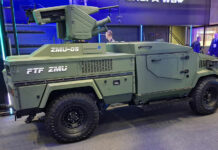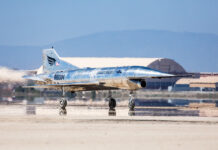Israel and Russia have signed today a military cooperation agreement and are negotiating the establishment of a joint venture to develop and produce unmanned aerial vehicles in Russia. Israel’s minister of defense Ehud Barak and his host, Russian minister of defense, Anatoly Serdyukov have signed a military cooperation agreement today, paving the way for tighter cooperation in the field of unmanned systems, counter terrorism and asymmetric, urban warfare – fields Russia expects a dialog with Israel could be beneficial.

“It is very important to us that in the transition to a new image, the Russian armed forces use the experience the Israeli armed forces have and the work they have done” Serdyukov said, adding Russia has bought 12 UAV systems from Israel, and 50 servicemen are currently being trained to operate them. Gradually opening to the world defense market, Russia is planning several acquisitions of major platforms, including helicopter carriers, and Italian armored vehicles. Past cooperation with foreign defense industries were limited to contracts where customers insisted on the integration of non Russian avionics or weaponry. The acquisition of Israeli UAVs was one of the first procurements foreign systems completed by the Russians.
The twelve UAVs Russia has acquired were delivered by IAI off-the-shelf, to fulfill ad-hoc requirements for military and homeland security uses. Among the off-the-shelf available systems were two Bird Eye 400 systems, eight I-View MK150 tactical UAVs and two Searcher Mk II tactical short range UAVs. Some 50 Russian military servicemen are currently undergoing training in the use of these systems.
A second contract worth $100 million is expected to be delivered this year. The Russians were also after more advanced UAVs of the Heron 1 class, but after long deliberation Israel’s defense ministry decided to exclude such advanced systems as ‘too sensitive’ for transfer to the eastern bloc. However, to enable the deal to go forward the MOD approved IAI to proceed and establish a Joint Venture with a Russian partner, to establish a UAV development and production center in Russia. Prospects for the Russian demand for such systems are estimated at $300 million. According to various estimates, the Russian military needs up to 100 UAVs and at least 10 guidance and control systems to ensure effective battlefield reconnaissance.
Despite the warming relations with the country once known to be its enemies largest arms provider, Israel is concerned of Moscow’s determination to pursue arms transfer plans to Syria, particularly of the Yakhont P-800 supersonic anti-ship missiles which keep Israeli naval vessels at risk throughout the eastern Mediterranean. Israel is particularly concerned about a possible transfer of such weapons from Syria to Lebanon’s Hezbollah. Another issue is the transfer of S-300 air defense missiles to Iran, which has been dragged for years. Moscow has never clarified its position regarding the fulfillment of the contract signed with te Iranians.
The issue of missiles transfer to Syria was dealt with Moscow on discrete channels for some time but has raised opposition in the Kremlin, as many officials refused to back off from the commitment to its Syria ally. In the past Russia denied Israel’s claims of the use of Syrian-supplied Russian made missiles by Hezbollah, during the 2nd Lebanon War in 2006. However, since that war Russian defense manufacturers continuously refer to the successful combat use of their Kornet and Metis guided missiles, without openly mentioning Hezbollah as the ‘end user’.
Two weeks ago Israel’s prime minister raised this issue with Russian prime-minister Vladimir Putin and today. This topic was also include din today’s meeting between Putin and Barak. The P-800 missiles have a range of 300 kilometers, carry a 200-kilogram warhead and feature a unique ability to cruise several meters above the surface, making it difficult to detected and intercept it.
















